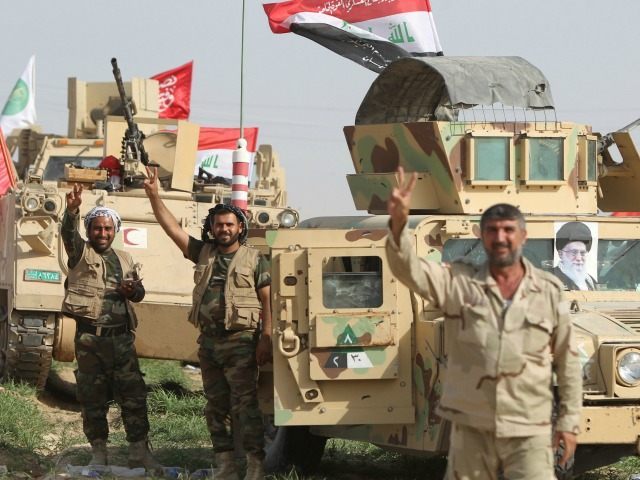American officials have identified a marked drop in the number of Iranian soldiers fighting in Syria for dictator Bashar al-Assad, a report surfacing after weeks of speculation that Quds Force commander Qassem Soleimani was injured in battle in Syria.
Bloomberg’s Eli Lake cites “U.S. officials” noting that American surveillance has found a drop in the number of soldiers in the Syria theater belonging to the Iranian Revolutionary Guard Corps, a different military wing than the elite Quds Force, so involved in executing terrorist acts that it has been designated by the U.S. Department of State a supporter of terrorism independent of the government of Iran. The dwindling presence has been witnessed in the last few weeks, “following the deaths and wounding of some of top officers in a campaign to retake Idlib Province and other areas lost this year to opposition forces supported by the West and Gulf Arab States.”
According to Lake, the number of Iranian Revolutionary Guard Corps in Syria is currently closer to 700 than the 7,000 the Wall Street Journal claimed two months ago.
There are a number of possible factors contributing to the reported exit of much of Iran’s manpower in Syria. One is the potential growth of Sunni rebel groups fighting Iran, independent of the Islamic State. These groups seek the overthrow of key Iranian ally Assad. Some, like the Free Syrian Army, are supported by Western forces, while others, like the Al Nusra Front, operate for terrorist groups like Al Qaeda. In pivotal conflict areas like Aleppo, Iran appears to be struggling against these groups, even when there is no Islamic State presence.
Such reports would explain how anecdotal testimony from those fighting in Islamic State areas who describe the ISIS jihadists as “eager to run away” and “a disappointment” can coexist with the news that Iranian and Russian efforts to prop up Assad appear to be, at best, stagnant.
The Wall Street Journal report claims that more than 50 Iranian fighters have been killed in the Aleppo area. The number of deaths has grown large enough that Iranian state media is acknowledging them. State outlets Fars News reported the deaths of three senior officers, one a bodyguard for former President Mahmoud Ahmadinejad, this week, with an explanation regarding how they found themselves in the line of fire apparently intended to prevent any public unrest regarding the operation:
Asked why the IRGC casualties in Syria are mostly ranking officers, [IRGC Public Relations Chief General Ramezan Sharif] said Iran does not have combat troops in Syria and has only sent advisors to help the Muslim nation, who provide counseling services and strategies to the Syrian army commanders in the battlefield and from a very close range to the forefront. He reminded that low-ranking officers are not fit for such a vital job.
While the nuclear deal brokered by President Obama may yield significant economic benefits to the Iranian regime, average Iranians are struggling to overcome major economic hurdles and are ripe for convincing to join opposition groups, according to some in the opposition. One human rights activist quoted in Saudi publication Al Arabiya explains that the number of funerals for Iranian soldiers fighting in Syria is growing “while Iranian people are facing economic difficulty and the unemployment rate has been increasing under Rowhani’s presidency.”
Not that Iran is relying exclusively on Iranian citizens to held Assad’s army. Iran has been exploiting the needs of would-be Afghan migrants with the promise of residency in Iran if they fight in Syria. At least one group run by Iran fighting in Syria, the Fatemiyoun Brigade, is comprised of Afghan refugees. “In terms of how they are recruited, deployed, and utilized in Syria, many Afghan Shi’ite fighters have suffered the fate of being used as cannon fodder,” Shiite jihadi group expert Phillip Smyth told the Agence France-Presse (AFP).
Reuters reports that Iran has recently begun turning to Pakistani mercenaries, as well, comprising a new militia called the Zeinabiyoun. It is believed that hundreds of Pakistanis are fighting on Assad’s behalf in Syria thanks to Iranian recruitment. They are believed to be directly run by the Revolutionary Guard Corps.
As for Soleimani personally, the highest ranking Iranian soldier known to be involved in the fight, his fate remains unknown. He is believed to have arrived in Syria in October. While Iranian media initially called reports of his injury a “sheer lie,” even printing an undated photo of him claiming it as proof that he was well, they later reported that he was, indeed, injured, though not gravely, as opposition groups have claimed.

COMMENTS
Please let us know if you're having issues with commenting.